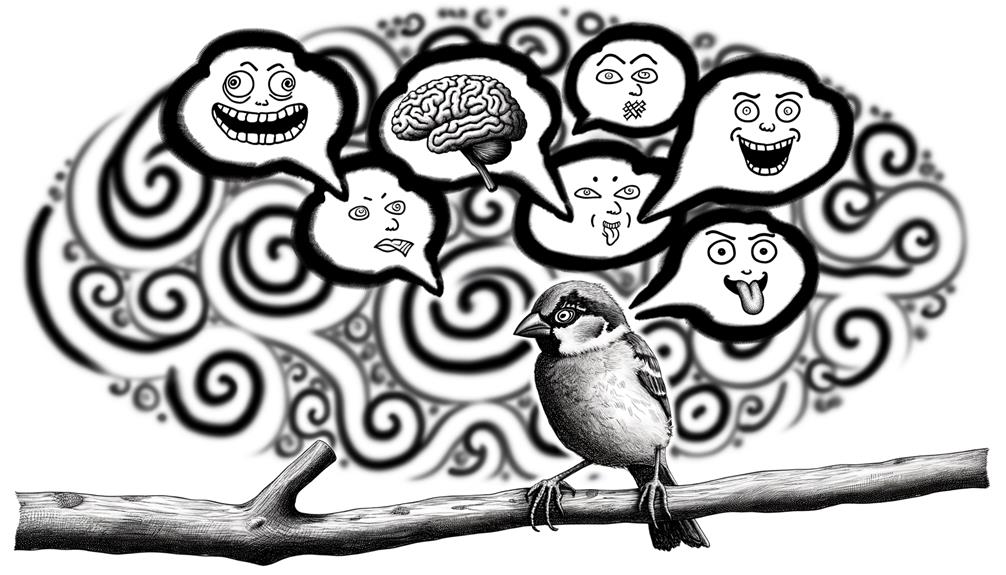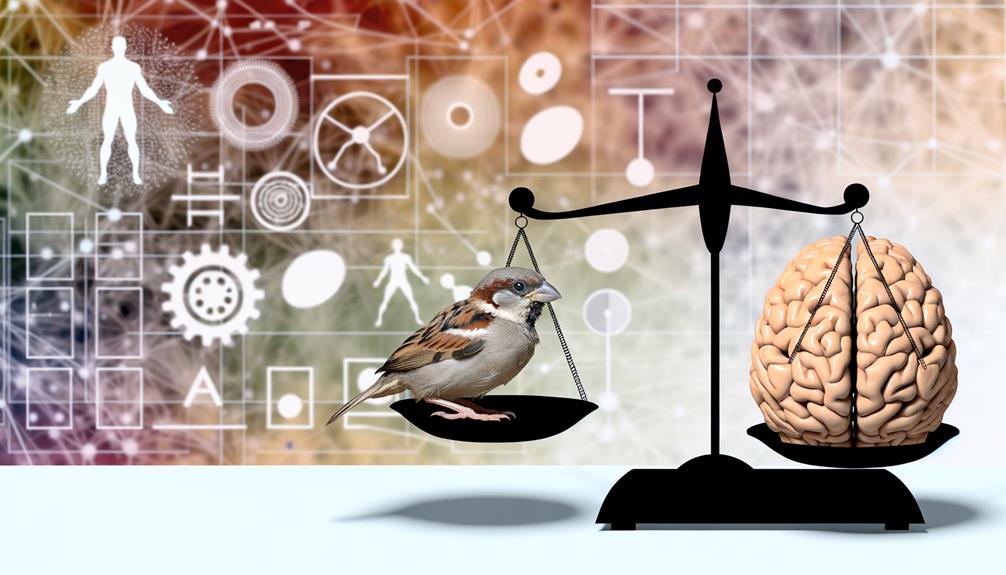Origin of “Even a Sparrow Has Bigger Brain” Meaning?
The phrase 'Even a sparrow has a bigger brain' highlights an individual's perceived cognitive inadequacy by comparing their intellect unfavorably to that of a sparrow. Sparrows possess notable problem-solving and spatial memory skills, symbolizing underestimated potential and challenging assumptions about brain size and intelligence.
Rooted in ancient rhetorical sarcasm, this idiom uses zoological imagery to emphasize societal expectations around intellectual capabilities. The enduring societal value placed on intelligence perpetuates the phrase's relevance, reflecting cultural and historical shifts in understanding cognitive abilities.
To explore the intricate interplay of these elements, one must consider deeper analyses of intelligence and societal norms.

Key Takeaways
- The phrase criticizes a person's perceived lack of intelligence.
- It emphasizes the cognitive deficiency of an individual compared to sparrows.
- Sparrows symbolize cognitive superiority due to their problem-solving skills.
- The phrase uses sarcasm to underscore expected intellectual capabilities.
- Ancient texts often used avian metaphors to highlight intelligence.
Origin of the Phrase

The phrase 'Even a sparrow has a bigger brain' originates from a historical context that critiques an individual's perceived lack of intelligence. This expression leverages the comparative small size of a sparrow's brain to emphasize the alleged cognitive deficiency of the person being critiqued.
The metaphor serves to underscore the individual's failure to exhibit expected intellectual capabilities or common sense. By invoking the diminutive brain of a sparrow, the phrase employs zoological imagery to convey a stark message about human cognition.
This linguistic construct operates as a potent rhetorical device, effectively using biological comparisons to make a sharp, memorable point about cognitive inadequacy. Its enduring usage highlights society's enduring preoccupation with intellectual competence and its perceived absence.
Historical Context
The phrase 'Even a sparrow has bigger brain meaning' first appeared in early literature as a critique of limited intellectual capacity.
Over time, its symbolic meaning evolved to emphasize the underestimated potential of seemingly insignificant entities.
This shift reflects broader societal changes in the perception of intelligence and value.
Early Uses in Literature
Among the earliest literary examples, ancient texts frequently utilized avian metaphors to convey intellectual disparity and human inadequacies. In Homer's epics, birds often symbolize divine intelligence, contrasting with mortal folly.
Similarly, in Aesop's fables, sparrows and other birds serve as analogs for human limitations and wisdom. Classical literature reveals a pattern where birds embody cognitive superiority, highlighting the perceived gaps in human understanding.
This tradition persisted in medieval writings, where avian symbols delineated sagacity and ignorance. By employing technical terminology and metaphorical constructs, these texts underscored the disparity between human and avian intellect.
Such literary devices provided a framework for readers to introspect on their intellectual and moral shortcomings, reinforcing the symbolic potency of avian imagery.
Evolving Symbolic Meaning
Throughout history, avian symbolism has continuously evolved, reflecting shifts in cultural perceptions and intellectual paradigms. Initially, birds were often interpreted through religious and mythological lenses, symbolizing divine messengers or omens.
As societies progressed through enlightenment and industrialization, the symbolic meaning of birds expanded, incorporating scientific observations and ecological awareness. Sparrows, for instance, shifted from mere symbols of simplicity and commonality to representations of resilience and adaptability.
In contemporary contexts, avian imagery frequently intersects with themes of environmentalism and conservation. This evolving symbolism underscores humans' dynamic relationship with nature, shaped by both cultural narratives and scientific advancements.
Consequently, the sparrow's symbolic connotations have adapted, mirroring broader societal transformations and intellectual progressions over time.
Sparrows' Cognitive Abilities

Sparrows exhibit impressive cognitive abilities. Particularly in problem-solving and memory. Their capacity for maneuvering through complex environments and recalling specific locations demonstrates advanced spatial memory. These cognitive skills suggest a higher level of neural processing than previously assumed.
These findings highlight the importance of understanding the cognitive abilities of seemingly ordinary species. It challenges traditional notions about the intelligence of birds and opens up new avenues for research in avian cognition.
Problem-Solving Skills
Studies reveal that sparrows exhibit remarkable problem-solving skills and cognitive abilities comparable to those of larger-brained birds. Their proficiency in maneuvering through complex tasks, such as food retrieval and nest construction, demonstrates advanced cognitive function. Comparative studies have shown that sparrows can adapt to changing environments and use tools, indicating high levels of innovation and adaptability.
| Task | Performance Level | Comparative Species |
|---|---|---|
| Food Retrieval | High | Crows, Parrots |
| Nest Construction | Advanced | Finches, Robins |
| Tool Use | Moderate | Woodpeckers, Jays |
| Environmental Adaptation | Exceptional | Pigeons, Starlings |
These findings underscore sparrows' cognitive capacities, challenging the notion that brain size solely determines intelligence. Such insights contribute significantly to ornithological research and understanding avian intelligence.
Memory and Navigation
Equipped with impressive spatial memory, sparrows can efficiently navigate their environments and recall locations of food sources with remarkable accuracy. This cognitive ability is facilitated by the hippocampus, a brain region associated with navigation and memory.
Studies have shown that sparrows utilize environmental cues and landmarks to create mental maps, ensuring efficient foraging and migration. They can remember specific details about food cache locations and revisit them when necessary, demonstrating advanced memory retention.
Additionally, sparrows exhibit route optimization, often selecting the shortest and safest paths. Their navigational skills are further enhanced by magnetoreception, allowing them to detect Earth's magnetic fields.
This sophisticated cognitive toolkit underscores the sparrows' adaptability and survival proficiency in diverse habitats.
Comparing Human and Animal Intelligence
How does the cognitive prowess of humans measure up against that of animals like sparrows?
Humans exhibit advanced cognitive functions, including abstract reasoning, problem-solving, and complex communication. This is facilitated by a highly developed neocortex.
Sparrows, while possessing notably smaller brains, demonstrate remarkable navigational skills and memory. Their hippocampus, essential for spatial memory, allows them to remember intricate migratory routes and food locations.
In comparing intelligence, one must consider species-specific adaptations.
Human intelligence is characterized by its versatility and ability to manipulate environments. In contrast, sparrows excel within their ecological niche, showcasing specialized cognitive abilities.
Therefore, intelligence manifests differently across species, shaped by evolutionary pressures and environmental demands, making direct comparisons inherently complex.
Sarcasm in Language

Sarcasm's historical origins trace back to ancient rhetoric, where it served as a tool for social critique and satire.
In literature, authors have employed sarcasm to convey complex themes and character dynamics.
Modern communication studies reveal sarcasm's nuanced role in conversational implicature and social interaction.
Historical Sarcasm Origins
Tracing the origins of sarcasm in language reveals its deep roots in classical rhetoric and ancient literature. The term 'sarcasm' derives from the Greek word 'sarkazein,' meaning 'to tear flesh,' illustrating its biting nature. Ancient Greek rhetoricians, such as Socrates, employed sarcastic techniques to expose logical fallacies and challenge interlocutors.
Roman orators like Cicero also utilized sarcasm to underscore absurdities and strengthen arguments. This rhetorical device was integral to satirical dialogues, enhancing persuasive strategies through irony and wit. In medieval times, sarcasm flourished in courtly and ecclesiastical discourse, often serving as a subtle form of social critique.
Sarcasm in Literature
Building on its historical significance, sarcasm has been a powerful literary device that authors wield to add layers of meaning, critique societal norms, and develop character complexity.
In literature, sarcasm often functions as a form of verbal irony, where speakers say the opposite of what they mean. This technique allows authors to subtly criticize social structures and highlight character flaws. For instance, Jane Austen's 'Pride and Prejudice' uses Mr. Bennet's sarcastic remarks to expose societal expectations and individual absurdities.
Additionally, sarcasm enhances narrative depth by revealing unspoken tensions and hidden motives. By employing sarcasm, writers create nuanced dialogues that engage readers, prompting them to think critically about the underlying themes and the characters' true intentions.
Sarcasm and Communication
Sarcasm serves as a multifaceted tool in communication, enabling speakers to convey complex emotional states, critique social dynamics, and reinforce group identity. The strategic use of sarcasm can signal intellectual superiority, foster social cohesion, and provide indirect criticism. Its effectiveness relies on shared cultural understanding and contextual cues, making it a sophisticated form of linguistic expression.
Key functions of sarcasm in communication include:
- Emotional Regulation: Allows speakers to express frustration or disdain without direct confrontation.
- Social Commentary: Offers a subtle means to critique societal norms or behaviors.
- Group Identity: Reinforces bonds within a group through shared understanding of sarcastic remarks.
- Intellectual Display: Demonstrates wit and cognitive agility to an audience.
Understanding sarcasm's nuanced role enhances the comprehension of interpersonal interactions.
Communication of Criticism
Effective communication of criticism demands a balance of clarity, tact, and constructive feedback to guarantee the message is both understood and actionable.
Criticism, when delivered effectively, should be specific, objective, and focused on behaviors or outcomes rather than personal attributes. This approach minimizes defensiveness and encourages receptivity.
Employing the 'sandwich method'—positive feedback, followed by constructive criticism, and concluding with positive reinforcement—can enhance acceptance.
Additionally, timing is essential; immediate feedback often holds more relevance. Avoiding ambiguous language and using direct statements ensures the recipient comprehends the intended message.
Ultimately, the objective is to foster improvement and growth, making the delivery of criticism a vital aspect of effective communication strategies within any organizational or interpersonal context.
Idioms and Cultural Impact

Idioms, deeply embedded in cultural contexts, reflect societal values and beliefs, influencing both communication and perception. These expressions often convey complex ideas succinctly. They impact everyday language and can shape understanding in several ways:
- Cognitive Framing: Idioms can frame thoughts, channeling interpretation through culturally accepted norms.
- Emotional Resonance: They evoke emotions linked to cultural experiences, enhancing relatability.
- Behavioral Guidance: Idioms often imply behavioral expectations, subtly guiding actions.
- Linguistic Economy: They offer a concise way to express intricate ideas, facilitating efficient communication.
Understanding idioms requires familiarity with the cultural and historical context in which they arise. Their continued use underscores their significance in maintaining cultural coherence and ensuring effective interpersonal communication. These points illustrate the profound impact idioms have on societal interactions.
Scientific Insights on Bird Brains
Recent research reveals that avian brains exhibit remarkable cognitive abilities previously underestimated by scientists. Studies indicate that birds possess advanced problem-solving skills, memory retention, and even tool use capabilities. Significantly, neuroanatomical investigations show that birds have a high neuron density, especially in the forebrain, enabling complex behaviors. Comparative analyses suggest that despite their small size, avian brains are highly efficient.
| Cognitive Ability | Description | Examples |
|---|---|---|
| Problem-Solving | Ability to find solutions to complex tasks | Crows using tools |
| Memory Retention | Long-term storage and recall of information | Navigational skills |
| Tool Use | Manipulating objects to achieve goals | New Caledonian crows |
| Social Learning | Learning behaviors from conspecifics | Song learning in songbirds |
| Communication | Complex signaling and language-like skills | Parrots mimicking speech |
These insights challenge previous assumptions and expand our understanding of avian intelligence.
Psychological Implications

Understanding the psychological implications of avian intelligence reveals how advanced cognitive abilities in birds influence their behavior and social interactions. Avian intelligence manifests in various ways, impacting their daily lives and interactions.
- Problem-Solving Skills: Birds demonstrate remarkable problem-solving abilities, utilizing tools and solving complex puzzles.
- Social Dynamics: Advanced cognition allows birds to navigate intricate social structures, establish hierarchies, and form alliances.
- Communication: Enhanced brain function supports sophisticated communication methods, including vocalizations and body language.
- Memory: Birds possess exceptional memory capabilities, aiding in navigation, food storage, and recognizing individuals within their species.
These cognitive traits highlight the psychological depth present in avian species, challenging preconceived notions about animal intelligence and promoting further exploration into their mental capabilities.
Broader Societal Norms
Within the context of broader societal norms, the recognition of advanced avian intelligence challenges traditional views of human superiority and prompts reevaluation of ethical considerations in human-animal interactions. This paradigm shift necessitates a reexamination of anthropocentric biases, questioning long-held assumptions about cognitive hierarchies.
Avian species exhibit complex problem-solving abilities and emotional depth, indicating that cognitive capabilities aren't exclusive to humans. Consequently, societal attitudes towards animal welfare, conservation efforts, and research methodologies must adapt. Ethical frameworks should incorporate the intrinsic value of avian cognition, advocating for humane treatment and protection of their habitats.
Conclusion
To conclude, the phrase 'even a sparrow has a bigger brain' underscores the intricate interplay between language, cognition, and societal norms. By examining sparrows' cognitive abilities and comparing them to human intelligence, the saying highlights both biological insights and cultural sarcasm.
Idioms shape our worldview, reflecting deeper psychological and societal constructs. Ultimately, this exploration reveals that even seemingly simple expressions carry profound implications, intertwining science and culture in a nuanced symphony of understanding.






